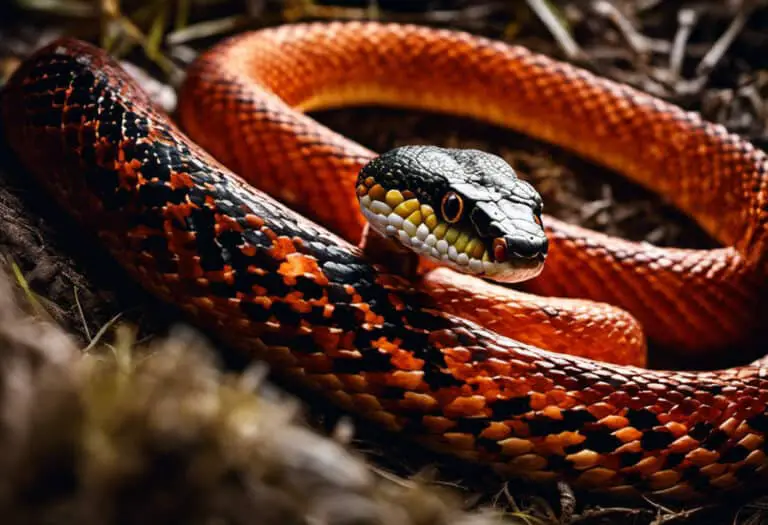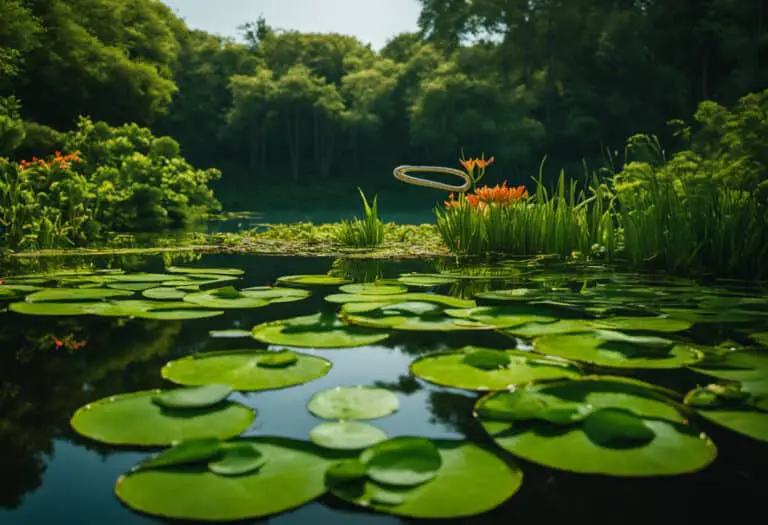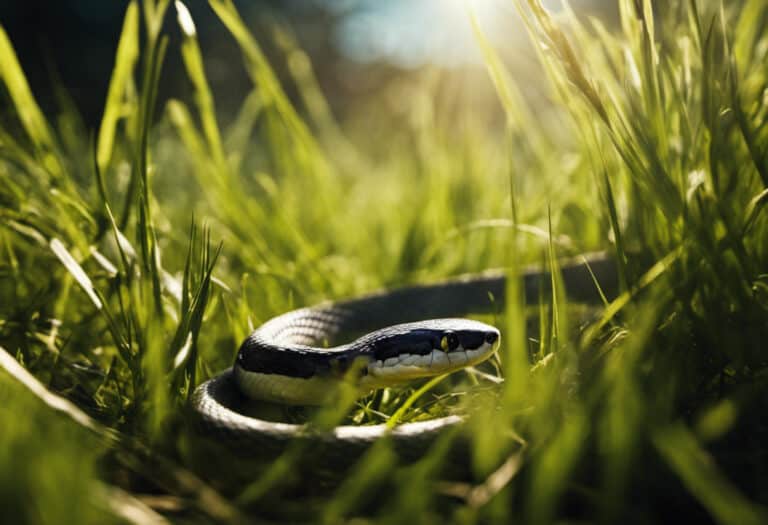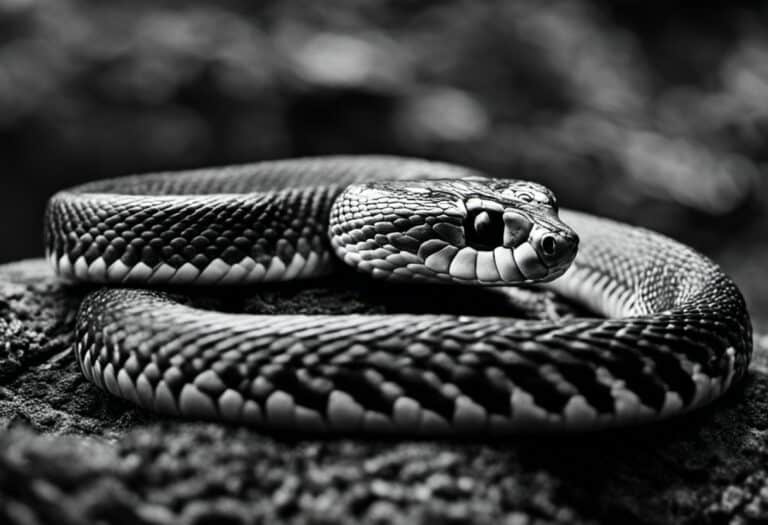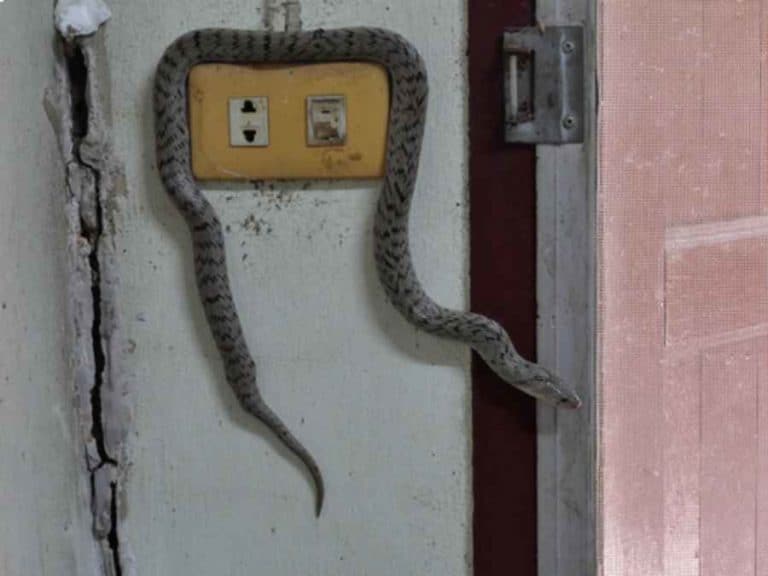Do Rattlesnakes Swim in Water?
Do you ever wonder if rattlesnakes can swim?
Well, prepare to be amazed.
These fascinating creatures, with their iconic rattle tails and venomous bites, not only survive in deserts, forests, and grasslands, but they also possess the incredible ability to navigate through water.
Swimming is a crucial skill for rattlesnakes, allowing them to explore new habitats and find food or mates.
Join us as we dive into the captivating world of rattlesnakes and uncover the extent of their swimming capabilities.
Key Takeaways
- Rattlesnakes are venomous and use their venom to kill their prey before eating it.
- Rattlesnakes are carnivores and feed on rodents, rabbits, lizards, and birds.
- Rattlesnakes can swim and use their swimming ability to escape from predators or hunt for prey.
- Rattlesnakes are attracted to water sources for temperature regulation, finding prey, and rehydrating.
Rattlesnake Swimming Abilities
Rattlesnakes, with their remarkable adaptations for swimming, possess the ability to effortlessly traverse bodies of water in search of new habitats and resources.
Water has a profound impact on rattlesnake behavior, influencing their movements and survival strategies. These highly skilled swimmers utilize their muscular bodies and flattened scales to glide through water with agility and precision.
The unique shape of their bodies allows for efficient propulsion, while their scales reduce drag.
In addition, rattlesnakes possess an exceptional ability to hold their breath for extended periods underwater, enabling them to explore aquatic environments in search of food or mates.
Adaptations for Aquatic Life
If you encounter a rattlesnake near a body of water, it’s important to keep a safe distance and avoid any interactions. Rattlesnakes are excellent swimmers and have adaptations that allow them to navigate through water with ease.
Their streamlined bodies and muscular tails enable them to move efficiently in aquatic environments. When swimming, they use lateral undulation, a serpentine movement, to propel themselves forward. Rattlesnakes may swim across bodies of water to reach new habitats, find food, or seek out potential mates.
In terms of hunting strategies, rattlesnakes utilize their swimming ability to ambush prey that may be near or in the water. They patiently wait for unsuspecting animals to approach the water’s edge, and then strike with lightning speed and accuracy.
Rattlesnakes and Water Sources
When near water sources, it’s important to be cautious and aware of the potential presence of rattlesnakes.
Rattlesnakes are known for their ability to swim, making them adaptable to various habitats. They utilize their swimming skills to escape predators or search for prey.
However, it’s important to note that while rattlesnakes can swim, they generally prefer to live on dry land. Water sources attract many animals that rattlesnakes feed on, providing opportunities for them to find food and rehydrate.
Unfortunately, the impact of water pollution on rattlesnakes and other wildlife is a concern. Contaminated water can harm their health and disrupt their ecological balance.
To protect these fascinating creatures and their habitats, it’s crucial to address and mitigate the effects of water pollution, ensuring their continued survival and freedom to thrive in their natural environments.
The Role of Water in Rattlesnake Habitat
Water plays a crucial role in the habitat of rattlesnakes.
Firstly, it serves as a temperature regulator, allowing rattlesnakes to seek cool areas near water sources when it’s hot and warm spots when it’s cold.
Secondly, water sources attract a variety of prey, such as frogs, mice, and birds, making it an important hunting ground for rattlesnakes.
Lastly, water is essential for their hydration, as they need to rehydrate and drink from these sources to survive in their arid environments.
Water as Temperature Regulator
Rattlesnakes use nearby water sources as a way to regulate their body temperature. Here are four ways water plays a role in the lives of rattlesnakes:
-
Thermoregulation: Water sources provide a cool environment for rattlesnakes to escape the heat. When it’s hot, they seek out these areas to lower their body temperature and prevent overheating.
-
Prey attraction: Water sources attract a variety of animals that rattlesnakes feed on. The presence of frogs, aquatic insects, mice, squirrels, birds, and their eggs near water increases the chances of finding food.
-
Rehydration: Rattlesnakes need water to survive. They go near water sources to rehydrate and drink, especially during dry and hot periods. Water is essential for their overall health and well-being.
-
Reproduction: Water plays a crucial role in rattlesnake reproduction. Mating often occurs near water sources, and female rattlesnakes may use water to aid in the development and laying of their eggs.
Attraction of Prey
When it comes to attracting prey, water sources play a crucial role for rattlesnakes. These reptiles are skilled hunters that rely on their temperature-dependent behavior to regulate their body heat and maintain optimal conditions for hunting.
Water sources have a magnetic effect on various forms of prey, including frogs, aquatic insects, mice, squirrels, and birds and their eggs. Rattlesnakes are drawn to these areas as they provide abundant opportunities for locating and capturing their desired meals.
Additionally, water sources offer a place for rehydration and drinking, which is essential for the snake’s survival. Some rattlesnake species, such as the timber rattlesnake, even choose to build their dens near water sources, further emphasizing the significance of these areas in their hunting strategies.
Importance for Hydration
If you encounter a rattlesnake near a water source, be aware that it may be there to rehydrate and drink. Rattlesnakes, like other animals, require water for their survival. Here are four key points about the importance of water for rattlesnakes and its impact on the ecosystem:
-
Hydration: Water is crucial for rattlesnakes to maintain their bodily functions and prevent dehydration. They may drink water directly from a water source or absorb moisture from the surrounding environment.
-
Thermoregulation: Rattlesnakes regulate their body temperature by moving to cool places near water when it’s hot. Water sources provide a cool environment for them to avoid overheating.
-
Prey Attraction: Water sources attract a variety of animals that rattlesnakes feed on, such as frogs, mice, and birds. By being near water, rattlesnakes increase their chances of finding prey, which is essential for their survival.
-
Ecosystem Balance: Rattlesnakes play a crucial role in the ecosystem as predators. By regulating the populations of their prey, they help maintain a balance in the ecosystem. Their presence near water sources ensures a healthy population of both rattlesnakes and their prey, contributing to the overall stability of the ecosystem.
Rattlesnakes and Temperature Regulation
Rattlesnakes rely on temperature regulation to maintain their optimal body temperature. When it’s cold, they seek out warm areas to increase their body temperature. This behavior allows them to adapt to different environmental conditions and ensure their survival.
When it’s hot, rattlesnakes seek out cool areas near water sources to lower their body temperature. This behavior also helps them adapt to their surroundings and maintain their body temperature within a comfortable range.
Overall, the ability of rattlesnakes to regulate their body temperature in response to changes in the environment is crucial for their survival. This adaptive behavior allows them to thrive in various habitats and ensures their overall well-being.
Temperature-Dependent Behavior
You should be aware that rattlesnakes regulate their body temperature by moving to warm places when it’s cold and to cool places near water when it’s hot.
Here are four temperature-dependent behaviors that rattlesnakes exhibit:
-
Basking in the Sun: Rattlesnakes will seek out sunny spots to warm themselves up. They’ll position themselves in areas with direct sunlight, such as rocks or open patches of ground, to absorb heat and increase their body temperature.
-
Seeking Shade: When it’s too hot, rattlesnakes will move to shaded areas to cool down. They may seek refuge under rocks, bushes, or other vegetation that provides protection from the sun’s rays.
-
Using Water Sources: Rattlesnakes are attracted to water sources as they can help regulate their body temperature. They may bask near water to cool off or seek shade near it to escape the heat. Additionally, water sources attract prey, providing opportunities for hunting.
-
Adjusting Activity Levels: Rattlesnakes may also adjust their activity levels based on temperature. During cooler times of the day, such as early morning or evening, they may be more active in searching for food. In contrast, during the hottest parts of the day, they may reduce their activity and conserve energy.
Importance of Water Sources
Finding and utilizing water sources is crucial for rattlesnakes to regulate their body temperature and ensure their survival in various habitats. Rattlesnakes have adapted to aquatic environments and are capable swimmers.
They use their swimming ability to escape from predators and to hunt for prey. Water sources not only provide opportunities to find food but also serve as a means for rehydration and drinking.
In habitats where water is scarce, the impact on rattlesnakes can be significant. Water scarcity can limit their access to essential resources, affecting their ability to regulate their body temperature and find food.
It’s important to understand the importance of water sources for rattlesnakes and to consider the impact of water scarcity on their survival in order to preserve their populations and maintain the balance of ecosystems they inhabit.
Habitat Preferences and Adaptations
Living in various habitats, rattlesnakes have adapted to different environments and developed specific preferences and adaptations to ensure their survival. Here are four important aspects to consider regarding rattlesnake swimming techniques and the impact of water availability on rattlesnake populations:
-
Swimming Abilities: Rattlesnakes are excellent swimmers and can navigate across bodies of water. They use their muscular bodies and undulating motion to propel themselves through the water.
-
Habitat Expansion: Swimming allows rattlesnakes to reach new habitats that may offer better food sources or mating opportunities. It provides them with the freedom to explore and expand their territories.
-
Water as a Resource: Rattlesnakes are attracted to water sources for various reasons. They may bask near water to regulate their body temperature or rehydrate and drink. Additionally, water sources attract prey items, increasing the availability of food for rattlesnakes.
-
Water Availability Impact: The availability of water directly impacts rattlesnake populations. In regions with limited water sources, rattlesnakes may struggle to survive and reproduce. The presence of water is crucial for their survival and plays a significant role in maintaining healthy rattlesnake populations.
Rattlesnakes as Predators in Aquatic Environments
Did you know that rattlesnakes are skilled predators in aquatic environments? While they’re primarily found on dry land, rattlesnakes are capable swimmers and can navigate through water with ease. Their ability to swim allows them to access new habitats and expand their hunting grounds.
Rattlesnakes employ various hunting techniques to capture their prey, including ambush and stealth. They patiently wait for unsuspecting prey to come near and then strike with lightning speed, injecting venom to immobilize their target.
However, the impact of water pollution on rattlesnake populations is a growing concern. Contaminants in water sources can negatively affect the health and survival of these snakes, leading to a decline in their populations. It’s crucial to address and mitigate water pollution to ensure the continued existence of these skilled aquatic predators.
Rattlesnakes’ Relationship With Water Prey
If you encounter a rattlesnake near a water source, it’s important to remember that they may be searching for prey such as frogs, aquatic insects, mice, squirrels, birds, or their eggs. Rattlesnakes have developed swimming techniques to navigate through water and hunt for water prey effectively.
Here are four strategies they use:
-
Stealthy Approach: Rattlesnakes move silently through the water, using their keeled scales to create minimal disturbance. This allows them to approach their prey undetected.
-
Ambush Hunting: Rattlesnakes often lie in wait near the water’s edge, camouflaged and ready to strike. They patiently wait for their prey to come near the water, then strike with lightning-fast precision.
-
Underwater Hunting: Rattlesnakes are capable of submerging themselves completely underwater while hunting. This technique allows them to surprise their prey from below and catch them off guard.
-
Coiling and Striking: When hunting in shallow water, rattlesnakes may coil their bodies and strike with incredible speed and accuracy. This hunting strategy is particularly effective for capturing small water prey like frogs or insects.
Rattlesnakes and Water Crossings
When it comes to water crossings, rattlesnakes have developed some impressive swimming techniques. These snakes are excellent swimmers and can traverse bodies of water with relative ease. Their ability to swim allows them to reach new habitats, find food, and even find mates.
Rattlesnakes use a serpentine motion to propel themselves through the water, similar to how they move on land. They rely on their muscular bodies and long, slender shape to navigate through the water efficiently.
However, while rattlesnakes are adept at swimming, water crossings can have a significant impact on their populations. These crossings can pose a threat to their survival, as they may encounter predators or face environmental challenges during their journey.
Additionally, water crossings can potentially separate populations, leading to reduced genetic diversity and limiting their ability to adapt to changing environments. Therefore, understanding the impact of water crossings on rattlesnake populations is crucial for their conservation and overall well-being.
The Timber Rattlesnake and Its Aquatic Dens
You can find the timber rattlesnake building its dens near water sources for temperature regulation. Here are four interesting facts about timber rattlesnakes and their swimming techniques:
-
Swimming Ability: Timber rattlesnakes, like many other snake species, are excellent swimmers. They’ve adapted to move through water using a combination of lateral undulation and serpentine movements.
-
Aquatic Dens: Some timber rattlesnake populations choose to build their dens near water sources. These dens provide the snakes with easy access to water for drinking and rehydration.
-
Temperature Regulation: Water sources play a crucial role in regulating the body temperature of timber rattlesnakes. They can seek refuge near water to cool down during hot weather or warm up during colder periods.
-
Conservation Importance: Understanding the swimming techniques and habitat preferences of timber rattlesnakes is crucial for their conservation. By protecting their aquatic dens and ensuring the availability of suitable water sources, we can contribute to the preservation of these fascinating and important snake species.
Frequently Asked Questions
How Deep Can Rattlesnakes Swim?
Rattlesnakes, known for their swimming abilities, can navigate bodies of water. While the depth they can swim varies, they use their skills to explore different habitats and to search for food or mates in their water habitats.
Can Rattlesnakes Stay Underwater for Long Periods of Time?
Yes, rattlesnakes can stay underwater for extended periods. They are skilled swimmers and use this ability to navigate and find food or mates. However, encountering a swimming rattlesnake can be dangerous, so it’s best to keep your distance.
Are There Any Specific Adaptations That Allow Rattlesnakes to Swim?
Rattlesnakes have specific adaptations for aquatic movement, allowing them to swim. These adaptations include their streamlined bodies, which reduce water resistance, and their ability to regulate buoyancy, enabling them to traverse bodies of water.
Do Rattlesnakes Actively Hunt for Prey in the Water?
Yes, rattlesnakes actively hunt for prey in the water. Their swimming abilities allow them to reach aquatic habitats where they can find food, such as frogs, aquatic insects, and small mammals.
Are There Any Specific Species of Rattlesnakes That Are Known for Their Affinity for Water?
Yes, there are specific species of rattlesnakes known for their affinity for water. They can swim across bodies of water to reach new habitats, find food, or mates. Their behavior and habits in aquatic environments are fascinating.
Conclusion
In conclusion, it’s quite remarkable to discover that rattlesnakes possess the ability to navigate and swim through bodies of water. These fascinating creatures have adapted to their environments and utilize water sources for various purposes, such as regulating their body temperature and finding prey.
Their swimming abilities allow them to explore new habitats and expand their territories. So, the next time you encounter a rattlesnake near water, appreciate the beauty of their aquatic skills and the unique role water plays in their lives.

